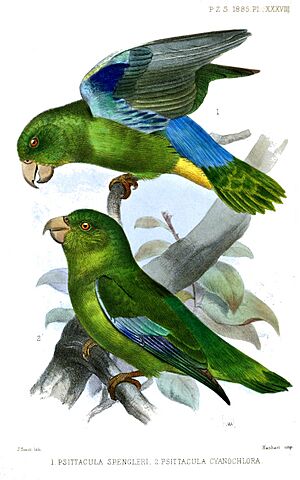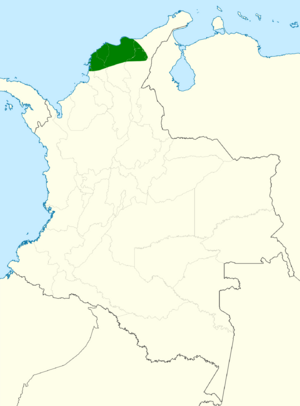Turquoise-winged parrotlet facts for kids
Quick facts for kids Turquoise-winged parrotlet |
|
|---|---|
 |
|
| Illustration of a turquoise-winged parrotlet (Forpus spengeli) (top) and green-rumped parrotlet (Forpus passerinus) (bottom) | |
| Conservation status | |
| Scientific classification | |
| Genus: |
Forpus
|
| Species: |
spengeli
|
 |
|
| Synonyms | |
|
|
The turquoise-winged parrotlet (Forpus spengeli) is a small, colorful parrot. It belongs to the parrot family. These birds are known for their bright feathers. They live in parts of South America.
Contents
What They Look Like
Turquoise-winged parrotlets are usually about 12 centimeters (5 inches) long. They weigh around 28 grams (1 ounce). Their bodies are mostly yellow-green. They have dark brown eyes and light peach legs and beaks.
Male and female parrotlets look a bit different. This is called sexual dimorphism.
- Males have bright turquoise feathers on their lower backs. They also have purple-blue feathers under their wings.
- Females do not have blue markings. Their foreheads and faces are a brighter yellow-green than the males'.
Like all parrots, turquoise-winged parrotlets have special feet. They have two toes pointing forward and two toes pointing backward. This helps them grip branches and food.
Where They Live
Turquoise-winged parrotlets are found in northern Colombia. You can see them near the Caribbean coast. They also live along the Rio Magdalena river.
These parrotlets prefer dry, open areas. They live in woodlands, savannas, and palm groves. You might also find them in semi-arid scrublands and pastures.
How They Are Protected
We do not have an exact number for how many turquoise-winged parrotlets there are. However, their numbers are thought to be going down. This is mainly because of human activity. People are changing or destroying their natural homes.
Even with these challenges, the turquoise-winged parrotlet is listed as Least Concern. This means they are not currently in great danger of disappearing. This listing comes from the IUCN Red List.
Behavior and Life
Social Life
Turquoise-winged parrotlets are very social birds. They often live in large groups. You can sometimes see flocks of up to 50 birds flying together.
Reproduction
The breeding season for these parrotlets is from May to August. During this time, female parrotlets lay their eggs. They usually lay 3 to 7 small white eggs.
What They Eat
Turquoise-winged parrotlets mostly eat fruits, seeds, and flowers. They enjoy fruits from Cecropia sp. trees. They also eat seeds from Mikania sp. and Trema micrantha plants. Their diet also includes flowers from Ambrosia sp. and Marcgravia sp.. Sometimes, they will also eat grass.
About Their Name
For a long time, the turquoise-winged parrotlet was thought to be a type of cobalt-rumped parrotlet. It was called Forpus xanthopterygius spengeli. But in 2015, scientists studied these birds more closely. They looked at how the birds were built. They decided that the turquoise-winged parrotlet was different enough to be its own species, F. spengeli. Other scientists agreed with this change in 2016.
However, some groups of bird experts still debate this. They do not all agree that it should be a separate species.


